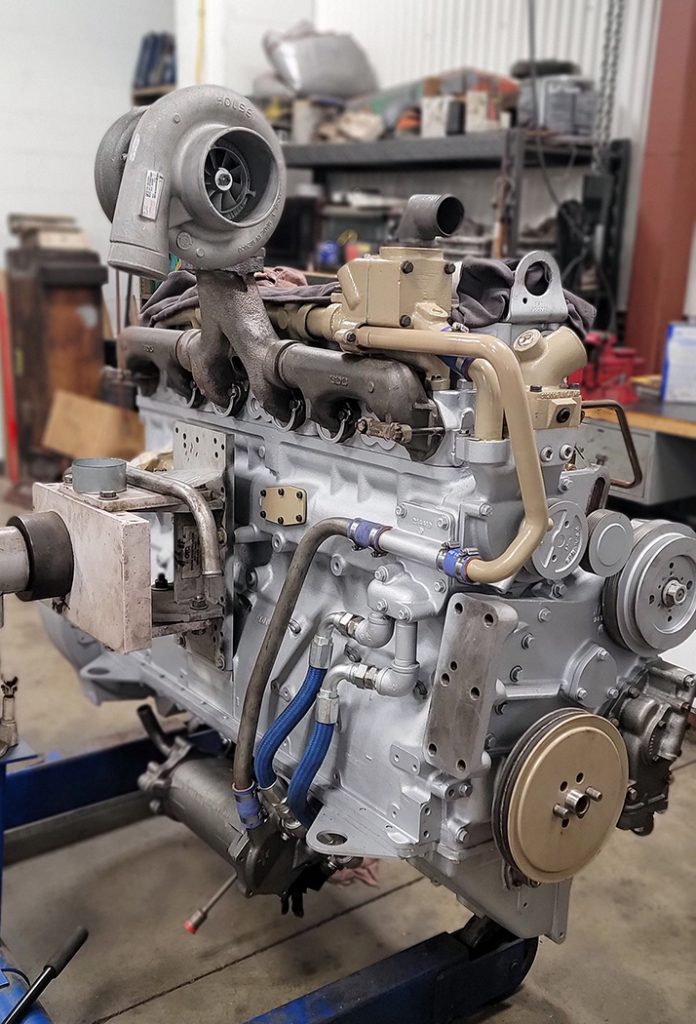
When Steve Belsky jokes about making bad decisions, one of them stands out – his “Pancake Engine” project. But if you ask anyone in the world of high-performance engineering, they might argue that this so-called “bad decision” is actually a masterpiece. Steve’s passion project is a 1948 Greyhound bus, a relic of a joint venture between American Car and Foundry, known for making rail cars, and Brill, a company famous for its trolleys. From 1946 to 1949, these two giants collaborated to produce Greyhound buses, with Steve’s specific model being built in 1948 and hitting the road in 1949 for inner-city routes. Today, the bus still carries its original marquee names – something Steve refuses to change, keeping a piece of history alive.
But nostalgia isn’t the only driving force behind this project. Steve has set his sights on a land speed record, joking that it’s all part of his 30-year plan. With a previous engine, he has already clocked 105 mph on the freeway – twice. But with the Pittsburgh Power-built Pancake engine and a specialized transmission, he aims to push the bus to an eye-watering 145 mph.
Steve’s journey started when he found the bus just three miles from his home in Austin, long before the internet made such searches easier. Scouring Hemmings Motor News, he specifically sought a mid-engine configuration with the door positioned behind the front axle. He chose this classic over a modern bus because, as a child, he associated these models with a sense of freedom – though, by the time he acquired it, the project was more about “surviving with a thrill” than anything else.
The bus’s original powerplant was a Holscott pre-war gas engine, but Steve replaced it with an engine from a Hungarian Ikarus “twist bus” that was headed for scrap. After refurbishing it through a Cummins dealership, he installed it in the old Greyhound bus using broomsticks as makeshift frame rail mock-ups, since the new engine was nearly twice the size of the original. However, he later regretted scrapping the historic Holscott engine – a decision he acknowledges as another “bad decision” perhaps.
When Steve began his project, the land speed record for a bus stood at 92 mph, but with his racing background, he was convinced he could surpass it. Years later, after extensive researching online, he found no evidence that anyone had officially beaten that record – until his own documented 105 mph run. Despite this achievement, Steve doesn’t believe the bus will ever make it to the Bonneville Salt Flats due to its weight – 15,000 lbs. without glass and 19,000 lbs. when fully assembled. The fragile salt surface, along with strict regulations, makes it unlikely that the bus will see action there. However, that won’t stop him from pushing forward on other proving grounds.
With our legendary expertise in Cummins Big Cam engines, we at Pittsburgh Power got involved with this project. Steve first met with Pete Sharp, our longtime Cummins specialist, who recently passed away. Pete helped him understand the intricacies of modifying a Big Cam to reach peak performance. What started as a backup engine quickly became the first in line as the primary powerplant. With that in mind, Steve said, “When you’re going for any kind of record like this, you have to be willing to plant your foot and blow up the engine.”
For the past two and a half years, Pittsburgh Power has been crafting this one-of-a-kind Pancake engine. It features Mechanical Variable Timing (MVT), originally developed as an emissions-friendly feature for California. However, in Steve’s case, the MVT system has been re-purposed to advance timing and “throw the heat,” essentially hot-rodding the engine in a way that defies its initial intent.
Steve’s Greyhound is more than just a bus, as it has another claim to fame – it’s the same model used in the classic Marilyn Monroe film Bus Stop. While he has found some scripts from the film inside his bus during the restoration, a club of Greyhound enthusiasts insist that his isn’t the bus from the movie. But for Steve, that’s just a minor technicality. “It’s the same kind of bus,” he says with a grin. “So, it was in a movie. That’s my story, and I’m sticking to it.”
Whether or not it’s a Hollywood icon, one thing is certain – this bus, with its custom-engineered engine, is on a mission to carve its own place in history. If Steve Belsky has his way, his so-called “bad decisions” might just make him a two-time record-breaker. Stay tuned! If you would like us to build a specialty engine for you, stop by our shop in Saxonburg, PA, call us at (724) 360-4080, or contact us through our website at www.pittsburghpower.com today. I would like to thank my associate Jordan Greathouse for writing this month’s article!

2 Comments
I believe the engines are “Hall Scott”.
This is the second pancake engine we have worked with in our 47 year history. Al Puhlman and his son Scott built one and installed it in a Crown bus and built a beautiful motorhome out of it. We reworked the injectors, fuel pump, turbocharger, duel fuel line kit and a larger torsional damper and mercury engine balancer. The Big Cam was around 700 hp . Big Cam Cummins engines are a natural high to operate when set up in this manner, instant throttle response, tremendous power and responsive.